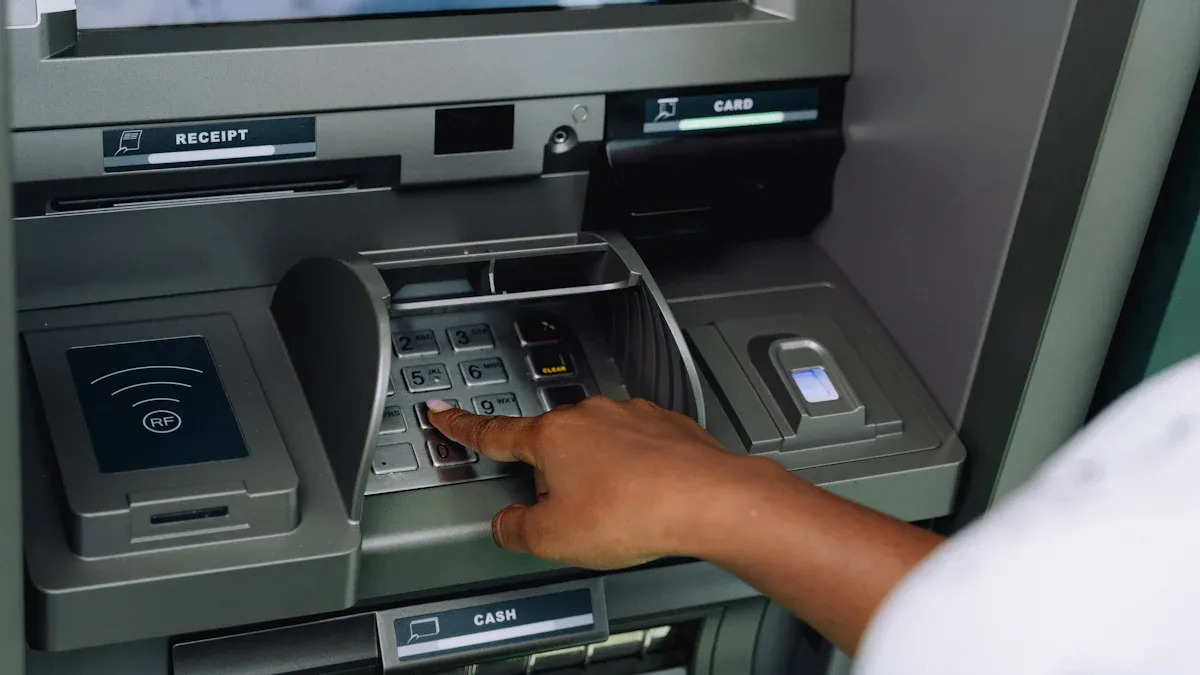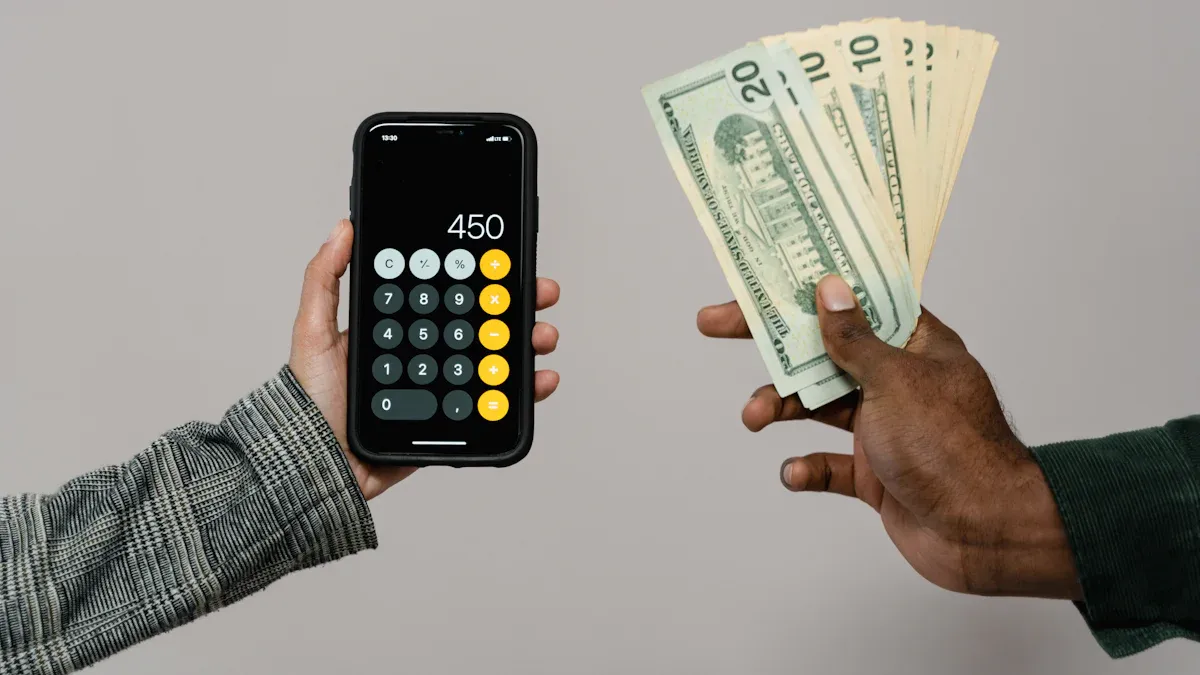- EasyCard
- Trade
- Help
- Announcement
- Academy
- SWIFT Code
- Iban Number
- Referral
- Customer Service
- Blog
- Creator
2025 Cash Withdrawal vs. Digital Wallet Convenience Comparison Study

Image Source: unsplash
In your daily life in China, choosing a digital wallet, especially a digital RMB wallet, typically offers greater convenience. Digital wallets allow you to pay with a simple scan or tap, saving time. Cash withdrawal remains indispensable for privacy protection and serving elderly users. In environments without devices or network access, cash withdrawal remains reliable. Digital wallets suit most consumption scenarios, while cash withdrawal is better for specific needs.
Key Points
- Digital wallet payments are fast and convenient, with simple registration, supporting scan-and-pay or tap-to-pay, suitable for most daily consumption scenarios.
- Cash withdrawal does not rely on networks or smart devices, ideal for no-network situations, device failures, or elderly users, offering strong privacy protection.
- Digital RMB supports offline payments without a network, enhancing payment flexibility, especially in remote areas and special environments.
- Users can choose payment methods flexibly based on their needs; the elderly can use cash or hardware wallets, while younger users prefer digital wallets.
- In the future, digital wallets will become more widespread, with continuous improvements in security and convenience, but cash withdrawal will remain irreplaceable.
Convenience Comparison

Image Source: pexels
Cash Withdrawal Convenience
When you use cash withdrawal in China, you typically need to visit a bank branch or ATM. You need to carry a bank card, enter a PIN, select the withdrawal amount, and wait for the machine to dispense cash. The process is straightforward but may involve issues like queuing, machine maintenance, or insufficient cash.
The biggest advantage of cash withdrawal is its independence from networks and smart devices. When your phone is out of power, the network is down, or devices fail, you can still meet payment needs through cash withdrawal. For the elderly or those unfamiliar with smartphones, cash withdrawal remains the most direct and reliable option.
In remote areas or small shops, cash payments are still common. You don’t need to worry about device compatibility or account information leaks. Cash withdrawal also offers high anonymity, protecting your privacy.
Tip: When withdrawing cash at institutions like Hong Kong banks, some banks charge a handling fee, typically settled in USD, with specific fees fluctuating based on the daily exchange rate.
Digital Wallet Convenience
When you open a digital wallet (e.g., digital RMB wallet) in China, the process is highly streamlined. You only need to register with a phone number, and some banks support facial recognition and big data risk control, allowing you to complete account opening in minutes without visiting a bank branch.
When paying, you simply scan a code, tap, or use NFC, and funds arrive instantly without going through traditional bank clearing layers. The payment efficiency you experience is as fast as cash transactions. Digital wallets also support dual offline payment functions, enabling smooth payments even without a network.
In scenarios like parking lots or subways, digital wallets enable contactless payments with automatic deductions, greatly simplifying the process. You don’t need to carry large amounts of cash or worry about change.
Digital wallets offer accessibility features for special groups. For example, you can use the accessible digital RMB app with optimized visual recognition and interaction. You can also choose hardware wallets like wristbands or badges to meet needs for those not accustomed to smartphone apps.
As a short-term foreign visitor to China, you can open a digital wallet with an overseas phone number or use a quasi-account hardware wallet, lowering the usage threshold and protecting privacy.
However, when using digital wallets, you may encounter issues like requiring separate agreements for certain payment scenarios or low awareness of digital RMB. You also need to focus on protecting transaction data privacy to ensure personal information security.
Table Comparison:
| Convenience Dimension | Cash Withdrawal | Digital Wallet (including Digital RMB Wallet) |
|---|---|---|
| Operation Process | Requires visiting a branch/ATM, multiple steps | Phone registration, account opened in minutes, easy operation |
| Time Cost | Requires queuing, waiting, carrying cash | Real-time arrival, scan/tap to pay |
| Device Dependency | No smart device needed, widely applicable | Requires phone or hardware wallet, some scenarios support no device |
| Network Dependency | No network needed, always available | Supports dual offline payments, some scenarios network-free |
| Privacy Protection | Highly anonymous, no trace left | Requires attention to data security, privacy measures improving |
You can see that digital wallets offer higher convenience and efficiency in most daily consumption scenarios. Cash withdrawal remains irreplaceable in scenarios without devices, networks, or for special groups. You can choose the most suitable payment method based on your actual needs and habits.
Usage Scenarios

Image Source: pexels
Daily Consumption
In daily shopping, dining, and transportation scenarios in China, digital wallets have become the mainstream payment method. You can use Alipay, WeChat Pay, or digital RMB wallets to complete payments with a scan or tap. According to 2025 market analysis, Alipay and WeChat Pay together hold over 90% of the digital wallet market share. Digital wallets account for about 30% of offline consumption in China. Digital RMB, as an emerging payment method, is seeing growing circulation. Although specific market share data for cash payments is unclear, you still use cash from withdrawals in small shops, wet markets, or when change is needed.
Tip: When topping up or withdrawing from digital wallets at Hong Kong banks, some banks charge a handling fee, settled in USD, with fees varying based on the daily exchange rate.
| Payment Method | Market Share (%) |
|---|---|
| Alipay | 54.5 |
| WeChat Pay | 38.8 |
| Total Digital Wallets | 90+ |
| Cash Payments | Not specified |
Emergency Cash Withdrawal
When you face emergencies like a dead phone, damaged device, or frozen account, cash withdrawal remains the most reliable option. Many elderly users unfamiliar with smartphone operations find cash payments more convenient. Authorities have set up dedicated cash payment windows and community volunteer services to help the elderly overcome mobile payment challenges. ATM devices are being optimized with multilingual support, graphical guides, and voice assistants to facilitate your and elderly users’ operations. In remote areas or urban-rural fringes, cash payment infrastructure is being expanded and maintained to ensure you can withdraw and pay anytime.
- You can withdraw cash at ATMs, and banks enhance maintenance to reduce payment interruptions during device failures.
- When withdrawing cash at Hong Kong banks, you benefit from higher security and multi-functional services like biometric authentication and remote operations management.
No-Network Payments
In no-network environments, digital RMB hardware wallets offer a new experience. You simply insert a super SIM card into an NFC-enabled Android phone, set it up in the digital RMB app, and pay by tapping the phone on a POS machine, even without network or power. You don’t need to scan or display a QR code, and payments work even with the phone locked or powered off. This feature has been rolled out in places like Beijing’s Xidan China Mobile and China Unicom stores. You can experience this convenience in shopping, transportation, and access control scenarios. The system supports small-amount password-free payments, ensuring fund security. You can remotely freeze the wallet to prevent unauthorized use.
Experts note that SIM card hardware wallets leverage NFC technology, eliminating the need for scanning, greatly enriching digital RMB use cases and improving user experience, especially for the elderly.
In no-network, no-power environments, you can use digital RMB hardware wallets for tap-to-pay or opt for cash payments after withdrawal, meeting diverse scenario needs.
User Experience and Security
Cash Withdrawal Experience
When using cash withdrawal in China, you experience the convenience of multi-channel services. Hong Kong banks and ATMs provide small-denomination withdrawals to meet change needs. Banks offer large-font mobile banking and staffed service windows to help the elderly operate easily. You can smoothly use cash in diverse scenarios like taxis, small merchants, and for foreign visitors to China.
However, you may encounter pain points. Some venues are less friendly to cash payments, and ATM small-denomination functions need upgrades. Convenience for foreign users in mobile payments and cash withdrawals also requires improvement.
Tip: Banks are optimizing ATM functions, adding foreign currency exchange points, and expanding foreign card acceptance to enhance your cash withdrawal experience across scenarios.
Digital Wallet Experience
When using digital wallets, payments and transfers become very simple. Mobile banking surveys show that account inquiries and transfers are the most popular functions, accounting for 73.34% of total transactions. You can quickly complete payments via scanning, tapping, or NFC. System security satisfaction reaches 94 points, with most users acknowledging digital wallet safety.
Digital wallets introduce mini-program technology, allowing you to access payments, wealth management, shopping, and travel services without installing multiple apps. This reduces the hassle of switching apps, offering a smoother experience. The mini-program ecosystem brings more business collaborations and discounts, further boosting your interest and satisfaction.
Privacy and Anonymity
When you pay with cash, no identity information is disclosed. Transactions between parties lack third-party records, making them hard to trace. Cash payments involve no real-name authentication or electronic transaction records, so banks and third parties cannot access your identity or transaction details. Cash payments offer the highest privacy protection among all payment methods.
Digital wallets (especially digital RMB wallets) implement multiple measures for privacy and data security. You can experience technologies like permission access control, multi-factor authentication, encrypted storage, and de-identification processing. Wallet designs follow the principle of “small-amount anonymity, large-amount traceability,” with some wallets opened using only a phone number, effectively anonymous. You can manage permissions independently, and the system collects only necessary information.
Note: While digital wallets enhance privacy protection, transaction data may still be traceable. Some digital currency transactions are openly transparent, posing privacy leakage risks. Technologies like multi-party computation and fully homomorphic encryption could theoretically improve privacy, but their practical efficiency is low and needs optimization. Regulators require real-name traceability to prevent financial risks.
Future Trends and Recommendations
Convenience Trends
You’ll find that digital wallets are rapidly gaining popularity in China. By July 2024, the digital RMB app had 180 million personal wallets, with pilot regions recording cumulative transaction volumes of 7.3 trillion yuan. User numbers in Guangdong, Shenzhen, and other areas continue to grow, with payment scenarios expanding.
Over the next three years, digital wallet convenience will continue to improve. You’ll experience more mobile and scan-to-pay scenarios. Biometric and dual-authentication technologies will make payments safer. AI and big data will offer personalized recommendations and intelligent assistants to help you complete payments quickly. Bank systems will use cloud-native platforms and real-time fund management technologies to shorten transaction times and boost efficiency. Digital RMB promotes financial inclusion, enabling more people to enjoy convenient payment services.
User Choice Recommendations
When choosing a payment method, you can make decisions based on your needs and habits.
- If you’re elderly, you may find mobile payments complex. You can choose elderly-friendly services, such as large-font mobile banking, accessible branches, and agent services. You can also use card-based or SIM card hardware wallets for payments in no-network environments. Hong Kong banks and others are optimizing cash services to ensure you can withdraw and pay anytime.
- If you’re a digital native accustomed to phones and apps, you’ll prefer digital wallets. You can enjoy scanning, tapping, or contactless payments for fast, secure, and diverse needs.
- In special scenarios like device failures or poor networks, you can flexibly switch between digital wallets and cash payments. Banks’ dual-conversion machines and smart tellers make switching between digital wallets and cash convenient.
Tip: When using digital wallets, protect personal information and choose wallets with high security certifications. When handling transactions at Hong Kong banks, monitor USD settlements and exchange rate changes to plan funds wisely.
In daily payments in China, digital wallets offer higher convenience and security. Digital RMB supports offline payments with no fees, suitable for most consumption scenarios. In remote areas or during network interruptions, cash withdrawal remains irreplaceable. Digital wallets, through smart contracts and diverse hardware forms, promote inclusive finance, helping more people access convenient services. In the future, digital wallets will become the mainstream payment tool, but you can still retain withdrawal rights to flexibly address different scenarios.
FAQ
Are digital wallet payments secure?
When you use digital wallets, the system employs multiple encryption and authentication methods. Digital RMB wallets support permission management. You can pay with confidence but should protect personal information.
Tip: When handling digital wallet transactions at Hong Kong banks, choose officially certified wallet types.
Does cash withdrawal incur fees?
When withdrawing cash at Hong Kong banks, some banks charge fees. Amounts are settled in USD, with specific fees varying based on the daily exchange rate.
| Service Type | Fee (USD) | Exchange Rate Reference |
|---|---|---|
| ATM Withdrawal | 2-5 | Based on daily rate |
Can digital wallets be used without a network?
You can use digital RMB hardware wallets to pay via NFC tap in no-network environments. You don’t need to scan or connect to the internet.
How should the elderly choose payment methods?
You can choose cash payments or hardware wallets for the elderly. Hong Kong banks offer large-font mobile banking and staffed windows to facilitate withdrawals and payments.
Which foreign users do digital wallets support?
As a foreign user, you can register a digital wallet with an overseas phone number. Hong Kong banks support quasi-account hardware wallets, lowering the usage threshold for consumption in China.
After a deep dive into the pros and cons of cash withdrawal and digital wallets, it’s clear that while payment methods are becoming more diverse, you may still face challenges with exchange rate fluctuations, high fees, and delayed transfers when managing cross-border funds. As the article mentions, fees in Hong Kong banks are often settled in USD, and opaque exchange rate spreads can erode your funds. BiyaPay was created to solve these pain points, offering a more comprehensive and efficient cross-border financial solution. On our platform, you can easily convert between various fiat and digital currencies and use our real-time exchange rate converter to say goodbye to the cumbersome processes and opaque fees of traditional banking. Our remittance fees are as low as 0.5%, and we support most countries and regions worldwide, ensuring your funds are delivered on the same day, significantly boosting transfer efficiency. Register now to start your new journey in smart finance.
*This article is provided for general information purposes and does not constitute legal, tax or other professional advice from BiyaPay or its subsidiaries and its affiliates, and it is not intended as a substitute for obtaining advice from a financial advisor or any other professional.
We make no representations, warranties or warranties, express or implied, as to the accuracy, completeness or timeliness of the contents of this publication.




Contact Us
Company and Team
BiyaPay Products
Customer Services
is a broker-dealer registered with the U.S. Securities and Exchange Commission (SEC) (No.: 802-127417), member of the Financial Industry Regulatory Authority (FINRA) (CRD: 325027), member of the Securities Investor Protection Corporation (SIPC), and regulated by FINRA and SEC.
registered with the US Financial Crimes Enforcement Network (FinCEN), as a Money Services Business (MSB), registration number: 31000218637349, and regulated by FinCEN.
registered as Financial Service Provider (FSP number: FSP1007221) in New Zealand, and is a member of the Financial Dispute Resolution Scheme, a New Zealand independent dispute resolution service provider.




















